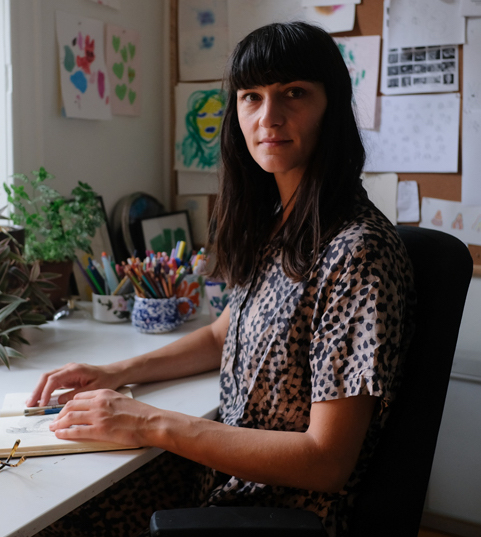

Animating Anxiety: Caroline Robert Discusses Her New Interactive Web Project ‘Brainstream’
Anxiety, insecurity, and depression are beasts that many of us know first-hand (especially in the pandemic). But it can be hard to explain precisely what it is that’s eating at us. Whether with a therapist or a family doctor, I sometimes get stuck trying to find the appropriate words to describe what I’m feeling. We end up wishing the other person could just jump inside our brain.

Caroline Robert’s interactive animated work Brainstream lets people do just that, in a sense. Made for the National Film Board of Canada’s (NFB) interactive division by Montreal’s Studio AATOAA, Brainstream presents itself as a (fictional) Health Canada project that allows anyone to get a brain massage by streaming their cerebral activity. In this case, the viewer is invited to massage the brain of a young woman named D.
“When my daughter was born six years ago,” says Robert, a visual artist known for designing Arcade Fire covers, “I was reading a lot about how the brain works in young children. Then I read about the brain in adults, and the way it functions and reacts to different stimuli or emotions. I was really fascinated by the way we can get stuck or it can change and reshape when it learns new things.”
Brainstream’s animation and design are relatively, and appropriately, straightforward. Reminiscent in parts of Peter Foldes’s classic NFB film Hunger (1974), the raw, scribbly look aptly matches the way many people draw (while channeling something of their inner chaos). Viewers — we are led to believe we are among many simultaneous participants — are asked by D to use their computer mouse to massage her.
The massaging triggers different parts of her brain, distorts and generates new images. During the experience (which we choose to participate in for either 5 or 20 minutes), we see D’s memories, from which we learn about her family, friends, and school life, her assorted menial activities (cutting her hair herself, unclogging a toilet, teaching her little sister how farts work), and her demons of shame, guilt, and anxiety.

“I wanted to experiment with 2d animation and create some kind of living matter that could react in real time to touch. We did some experiments like this in past projects for the NFB,” says Robert, who frequently collaborates with her AATOAA (and Brainstream) colleagues Vincent Morisset and coder Édouard Lanctôt-Benoit; the group previously made the interactive work Bla Bla for the NFB. “I also wanted to use animation to morph at any time without a timeline,” she adds.
It’s a fascinating idea. On the one hand, we learn more about social anxiety, self-loathing, and the unpredictability of the brain. D addresses her issues in a funny, self-deprecating manner that takes the edge off them, for her and us. As viewers, we find comfort in D’s openness. She humanizes her experiences, making them relatable, humorous, and fixable.
“I wanted to create characters that were annoying, but that become cute in a way so that we can distance ourselves from them and not take them so seriously,” adds Robert. “We can be so intense with ourselves and say things to ourselves that are really mean.”

Brainstream is relatable for any age group, but teenagers will no doubt connect strongly. The choice of a teenage female protagonist aptly reflects the prevalence of anxiety among young people growing up in the age of social media and the internet. They are being bombarded with information, images, and constant bs. Many do not yet have the tools to sort the good from the nonsense.
“I have lots of friends with kids who have a lot of anxiety,” says Robert. “It wasn’t my original intention to make something for young girls or young people in general, but many kids have more anxiety than ever.”
Brainstream is also subtly subversive in that it encourages viewers to use their mouse for a purpose with more meaning than scrolling through social media feeds. “We spend so much time and energy just moving our fingers or mouse, and I thought that maybe I could do something to take advantage of this energy, to translate it into something that could help someone,” says Robert. “This was the premise of the brain massage idea. A tiny gesture could be gratifying and meaningful in some way. You would be helping someone just by touching your screen.”

At times, Brainstream feels too facile. Many of the issues it addresses are linked to our society. We are living in a hyper-consumerist, capitalist system that doesn’t suit us. The system is making us sick and to understand that, we need to go beyond an individual’s brain and explore the social and economic conditions triggering these mental health issues. Granted, that’s a big, messy, complicated issue with no overnight cures.
But as viewers, we feel better from listening to D. Hers is like a safe, friendly voice in our head (enhanced by Mathieu Charbonneau’s sensitive, almost ASMR-like soundscape). We feel we’ve helped her, and in doing so we feel a bit better about ourselves.
Brainstream reminds us that human connection — being able to listen and engage with each other — is key to finding some inner harmony. When we see that we’re in this shit together, it can make the demons a lot more manageable, and even laughable.
Experience “Brainstream” here.
